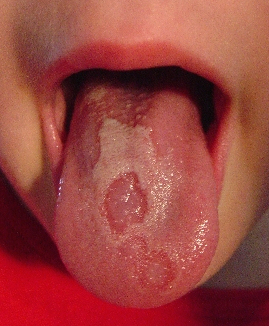Children and toddlers get Geographic Tongue as often as everyone else but it always seems more difficult when someone so young gets it. This is especially true since most children’s tongues are so perfect. I always tell people that they should look carefully at a healthy child’s tongue to get an idea of what a tongue is meant to look like. The papillae (little bumps or taste buds) on a healthy child’s tongue look new and fresh and well formed. But unfortunately the taste buds on a child with Geographic Tongue are missing. And although “experts” say this doesn’t result in a loss of taste… logic and personal experience tells me that it does.
In a 2005 study in Spain, three Dental professors at the University of Madrid analyzed research on tongue problems in children. In their research they found widely varying statistics of the rate of Geographic Tongue found in studies in different parts of the world. They found that 4.48% of Spanish school children had geographic tongue in one study but only 2% of Mexican school children. One Brazilian study of children from Kindergarten to 12th grade found 9.08% had geographic tongue. Another Brazilian study found 21% of children from Kindergarten to 5th grade had geographic tongue. While 1.6% of South African preschool children studied had geographic tongue and only 0.6% of American (USA) school children studied had it.
Based on all of these studies, the authors concluded that it often appears between the ages of 6 to 12 months and is most frequently observed at around the age of four to four and a half. But of course it can occur at any age.

So why do children and toddlers get Geographic tongue?
Well, the simple answer is they get it for exactly the same reason that adults get it.
Since my major premise is that it is usually related to nutrition my guess would be that as they start eating on their own they are “picky eaters” and so aren’t getting all the nutrition they need. Conventional wisdom has it that if they are given a wide variety of foods to choose from they will eventually balance their own diets.
Perhaps at one time this was true when all the foods were healthy and full of vitamins but somehow I don’t think it works that way anymore. I think it is more likely that given the choice, most kids will live on candy and ice cream, the more sugar the better, the emptier the calories the more they like them.
About the Author: Timothy McMahon of Healthy Tongue Secrets has published a book compiling the various nutritional and other methods of treatment that have found success among sufferers of Geographic Tongue. He has created a new updated version called, Treating and Beating Geographic Tongue and Other Tongue Problems for more information about this book and how to get your copy Click Here OR to see the special edition created just for geographic tongue in toddlers and children.
